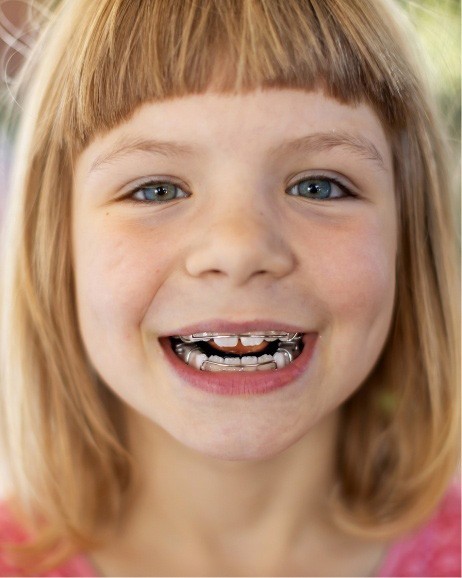Phase I Pediatric Orthodontics – Amityville, NY
Helping Small Smiles Thrive

As a board-certified orthodontist, Dr. Justyna has helped patients of all ages address concerns involving dental, bite, and jaw misalignment. For children with mixed dentition, or teeth that are both permanent and temporary, Phase 1 pediatric orthodontic treatment in Amityville may be recommended to help guide the development of their smile and minimize the severity of future orthodontic issues they may face. If your child is between six and nine years old and you feel they could benefit from early orthodontic intervention, schedule a consultation with our team today!
Why Choose Amityville Orthodontics for Phase I Pediatric Orthodontics?
- An Experienced, Board-Certified Orthodontist
- We Accept & Maximize Dental Insurance
- Personalized, Boutique-Style Orthodontic Care
How Phase I Orthodontics Works

Phase 1 orthodontic treatment is designed to address developmental dental problems before they require extensive intervention down the road. If your child is between six and nine years old and has both temporary and permanent teeth, we may recommend Phase 1 treatment. Here are some situations in which this treatment may be recommended for your child:
- Their baby teeth have fallen out prematurely.
- They have a significant speech impediment caused by their dental alignment.
- Their adult and temporary teeth protrude from their mouth.
- Their teeth don’t come together evenly.
- They regularly breathe out of their mouth.
- Non-nutritive habits (like thumb and pacifier-sucking) altered their dental development.
Based on the unique orthodontic issues your child faces, like protruding teeth, bite problems, or crowding, Dr. Justyna will develop a customized treatment plan for them. These can include expanders or growth appliances to help guide jaw development or partial braces or space maintainers to ensure their permanent teeth erupt and are properly aligned. If your child still struggles with thumb or pacifier-sucking, Dr. Justyna can provide you with helpful tips to curb their habit.
Who is a Good Candidate for Phase I Orthodontics?

Children who are recommended for Phase I Orthodontics tend to have:
- Overcrowded or crooked teeth
- Gapped teeth
- Protruding teeth
- Difficulty speaking
- A disproportionate jaw
- Sleep breathing issues that cause them to breathe with their mouth open
Bringing your child in for a complete consultation is the only way to know for sure if this early form of orthodontic treatment is right for them.
The Benefits of Phase I Orthodontics

When discussing whether your child should receive Phase I Orthodontics, you can expect our team to go over the available benefits that can come from moving forward with this type of treatment. By bringing them in at the age of 7, we can establish a baseline for their smile and determine whether early orthodontics will deliver the results needed to avoid more invasive procedures in the future.
By beginning orthodontic care at a young age, we can administer treatment while their face and mouth are still developing, which allows for easier movement. We can also reduce the potential risk of more serious issues developing later on in life (i.e., sleep breathing disorders, impacted teeth, poor jaw and bone growth, or greater bite misalignment).
It’s also possible that Phase I treatment corrected the issue, making it possible for your child to no longer need braces later on!
What Happens During Phase II?

Phase II orthodontic treatment doesn’t start right after the first phase. Instead, your child will have a period to rest and allow the rest of their permanent teeth to safely grow. During this time period, our team may recommend a retainer to help ensure any progress from their Phase 1 treatment is maintained. Then, once all of their permanent teeth are grown in and they’re eligible for traditional orthodontics (typically, this is between 11 and 13 years old), we can outline each of their appliance options. With both phases of treatment, our goal is to help ensure that your little one’s smile develops into one that’s healthy, aligned, and even, boosting their oral and overall health.
Phase 1 Orthodontics FAQs

If you believe your child could benefit from phase 1 orthodontic care, our Amityville team is ready to welcome them in for a consultation! Before you book an appointment, though, you might be eager to gather more information about the road ahead. Below, you will find answers to some important FAQs. If your specific questions are not included here, reach out to us directly; we will be pleased to speak with you!
When Does Phase 1 Orthodontics Take Place?
Phase 1 orthodontics, which is also known as interceptive orthodontics, usually takes place when a patient is 6 – 9 years old. This is around the time when children start to lose their baby teeth, and their permanent teeth start to erupt.
Because timing is so important with this type of care, the American Association of Orthodontists recommends that all children visit an orthodontist for a checkup by the time they turn 7 years old.
What Issues Can Phase 1 Orthodontics Address?
Phase 1 orthodontics is a versatile approach to treatment that can address a range of issues, including various problems with jaw and tooth development. For example, it may help to take care of overbites, underbites, crossbites, and open bites. Phase 1 orthodontic appliances can also be used to guide the growth of the jaw to ensure that there is enough room in the dental arches for all of a child’s teeth.
What Appliances Are Used in Phase 1 Orthodontics?
Phase 1 orthodontics may use a variety of appliances:
- A palate expander can be used to widen the upper jaw and create more space in the top row of teeth.
- A space maintainer can help to preserve space in the dental arches if a child loses one or more of their baby teeth too soon.
- Limited braces can help to straighten the teeth.
- A Herbst appliance may be connected to steel crowns on a child’s teeth to correct jaw imbalances.
- After the completion of treatment, a retainer can be used to maintain the patient’s results.
Is Phase 1 Orthodontics Painful?
The appliances are designed to rest as comfortably as possible against a patient’s oral tissues. However, they work by applying pressure to targeted parts of the mouth. As you might imagine, this can cause some mild to moderate discomfort. Usually, the pain is temporary and goes away after a patient has a bit of time to adjust to their appliance.
You may be able to reduce your child’s discomfort by giving them small doses of pain medication. Tylenol tends to work well. You can also soothe discomfort and swelling by providing cool foods. For example, you can give your child a sugar-free popsicle to suck on or offer a small serving of ice cream.
